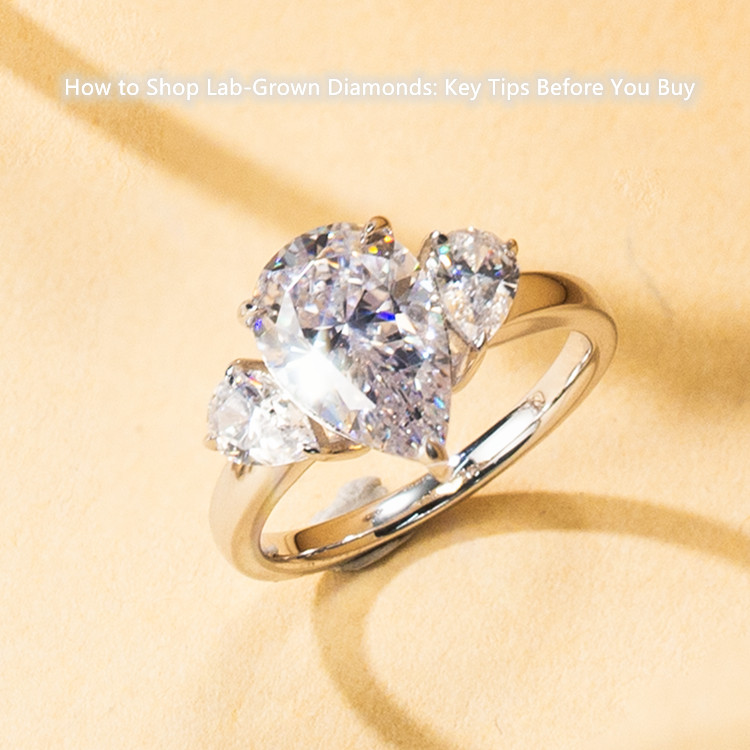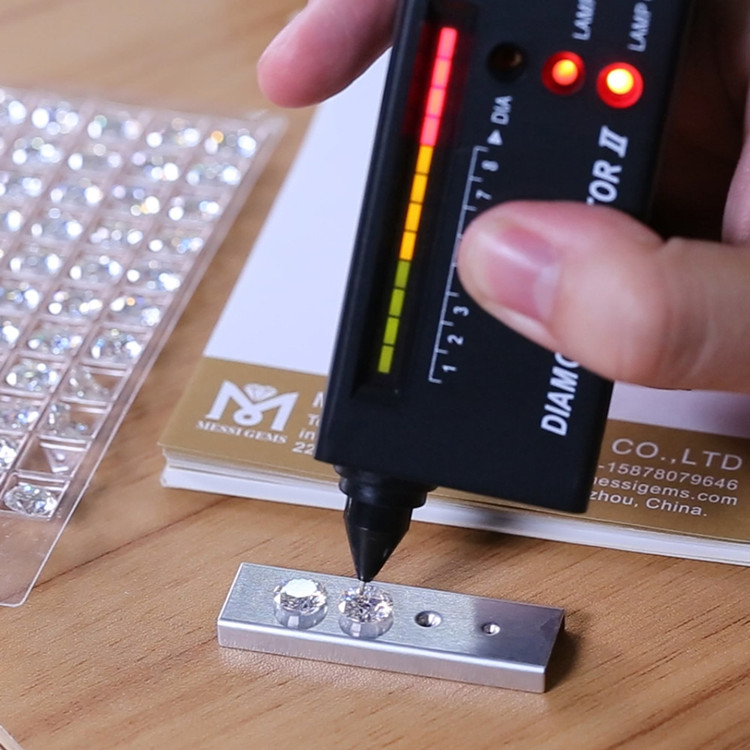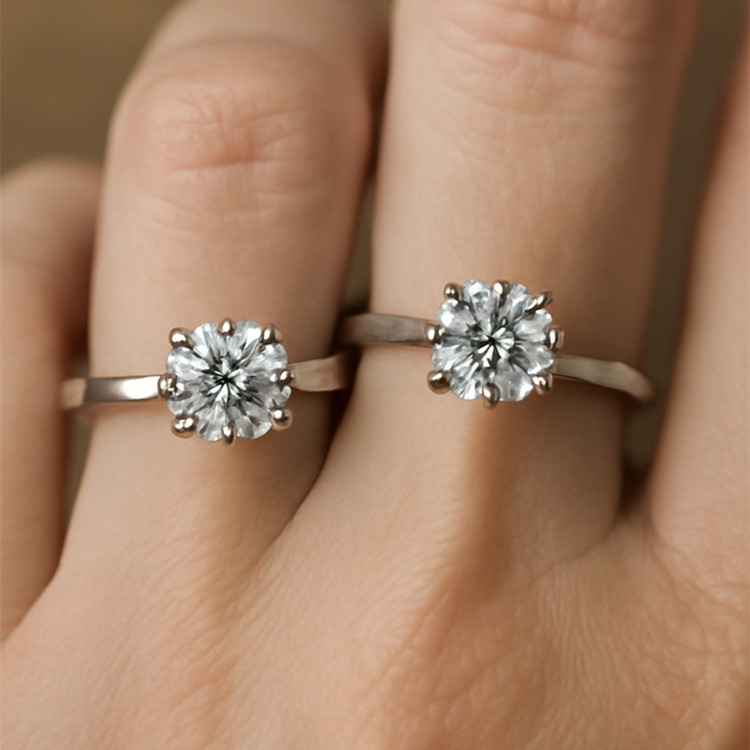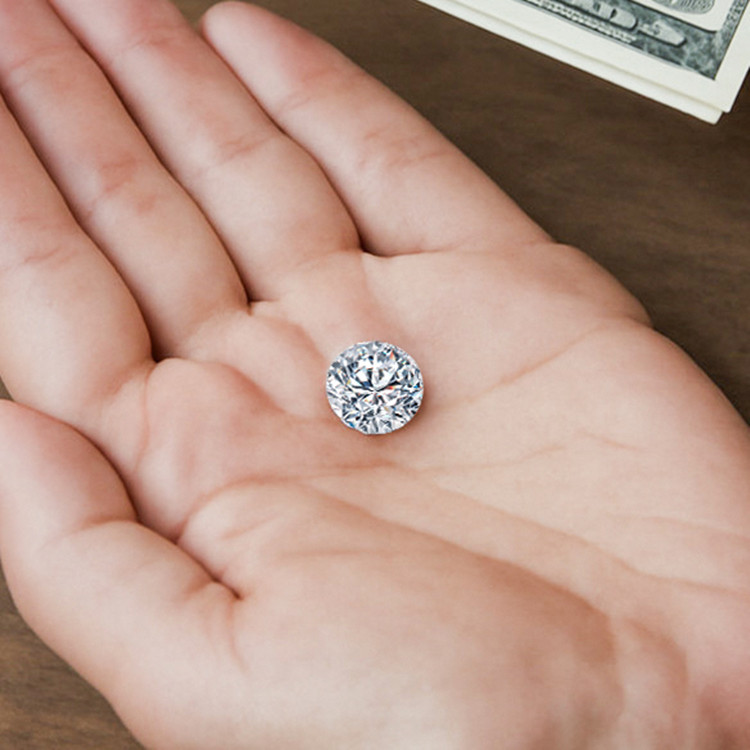
How to Shop Lab-Grown Diamonds
Introduction
Choosing a diamond—whether it’s a dazzling natural gem or a cutting-edge cvd diamond grown in a lab—can feel overwhelming. Today’s consumers demand not only sparkle but also transparency, sustainability, and value.
With flawless vvs simulated diamonds becoming more accessible, and “3 carat diamond ring” designs trending worldwide, you might wonder:
Are lab-grown diamonds as real as mined stones?
·Which metal—18K white gold or platinum—best suits daily wear?
·Should you aim for VS1, VS2, or SI1 clarity when no inclusions are visible to the naked eye?
·Is a single large center stone more elegant than multiple smaller diamonds?
What resale value can you expect if you choose a lab-created stone?
And how should you care for your ring to preserve its brilliance? In this comprehensive bilingual guide, we’ll provide professional insights and practical take-home tips to help you navigate:
• At-home methods to tell a lab-grown diamond from a natural one
• Side-by-side comparison of 18K white gold vs platinum settings
• Clarity grade selection—VS1, VS2, SI1—when eye-clean is your goal
• Design choices: a standout 3 carat diamond ring vs a cluster of smaller gems
• The realities of reselling CVD or lab-grown diamonds
• Safe wearing habits during showers and workouts
• Everyday cleaning routines, plus ultrasonic and steam cleaning advice
Whether you’re shopping for an engagement ring or simply expanding your jewelry knowledge, this guide marries solid gemological facts with practical consumer tips to ensure you buy, wear, and maintain your diamond—and metal setting—with confidence.
Lab-Grown vs. Natural: At-Home Testing Tips
Is there a foolproof way to differentiate a
lab grown cvd diamond from a natural diamond at home? The short answer: not entirely.
Both lab-grown and mined diamonds share the same chemical composition (pure carbon) and crystal structure, making them virtually identical under most consumer tools. However, a few basic methods can offer clues:
• Thermal Conductivity Pen: Natural and lab diamonds conduct heat similarly, so a standard diamond tester won’t reliably tell them apart. Some advanced testers can detect subtle differences in thermal response, but they’re expensive and require professional calibration.
• Magnification (10× Loupe): Look for laser inscriptions along the girdle (edge) of the diamond—many lab-grown stones are inscribed with “CVD” or brand names. Inclusions in CVD diamonds often appear as metallic flux or pinpoint clusters, while natural diamonds display minerals like garnet or olivine.
• Ultraviolet Light (UV): Under short-wave UV, natural diamonds and CVD diamonds can fluoresce differently. Some CVD diamonds exhibit a bluish or greenish glow; certain naturals appear yellowish. Yet fluorescence varies greatly and can be misleading.
• Professional Grading Report: The surest way to know is to obtain a grading certificate from a reputable gem lab (GIA, IGI, HRD). These labs clearly state origin: “Natural Diamond” or “Laboratory Grown Diamond—CVD/Growth Process.”Bottom Line: If you’re serious about knowing your diamond’s origin, rely on a certified grading report. At-home tools might hint at clues but can’t guarantee 100% accuracy.

18K White Gold vs Platinum: Daily Wear Showdown
Choosing between 18K white gold and platinum for your diamond setting depends on your lifestyle, budget, and aesthetic preference. Here’s what you need to know:
Durability & Hardness
• 18K White Gold: An alloy of gold (75%) and metals like palladium or nickel. Slightly harder than pure gold but softer than platinum. Over time, the rhodium plating that gives it a bright white finish can wear off, revealing a faint yellowish hue.
• Platinum: One of the densest and most durable metals used in jewelry. Hypoallergenic and naturally white—no plating required. While it can scratch, the metal displaces rather than wears away, creating a “patina” some find charming.
Weight & Feel
• 18K White Gold: Lightweight and comfortable for everyday wear.
• Platinum: Heavier on the finger, offering a luxurious, substantial feel.
Maintenance & Cost
• 18K White Gold: Lower upfront cost but requires periodic replating (every 1–2 years) to restore its bright finish.
• Platinum: Higher initial investment but minimal maintenance—just occasional polishing to smooth patina and scratches.
Price: Platinum typically costs more per gram than 18K white gold.

Recommendation:
• If budget and lightness matter most, choose 18K white gold and plan for rhodium touch-ups.
• If you want a naturally white, hypoallergenic metal with a premium feel—and don’t mind the extra weight and cost—platinum is your best friend.
Clarity Selection: VS1, VS2, or SI1 When Eye-Clean Matters
VS1, VS2, and SI1 dominate the market because they strike a balance between eye-clean appearance and value. Here’s how to choose when no inclusions are visible to the naked eye:
• VS1 (“Very Slightly Included 1”): Inclusions are extremely difficult to detect under 10× magnification. Perfect for those who want a near-flawless look with minimal price premium.
• VS2 (“Very Slightly Included 2”): Inclusions are slightly easier to spot under magnification but remain invisible to most people without a loupe. Offers a sweet spot in price vs. appearance.
• SI1 (“Slightly Included 1”): Some inclusions might be visible under 10× magnification and occasionally to a careful naked-eye inspection under certain angles or lighting. SI1 often gives the best price savings while still appearing flawless in everyday wear.
Factors to consider:
• Carat Weight & Cut: Larger diamonds and shallower cuts magnify inclusions, so you may lean toward VS1/VS2 if you’re purchasing a 3 carat diamond ring or bigger.
• Setting Style: A halo or pave setting can mask minor inclusions by creating extra sparkle around the center stone.
• Personal Sensitivity: If you’re picky about microscopic details, VS1 gives peace of mind. If you prioritize budget, SI1 is less expensive than VS2 of similar carat and color.
Recommendation:
1. Under 1.5 carats: SI1 is usually safe if you verify “eye-clean” in person.
2. 1.5–2.5 carats: VS2 hits a good balance.
3. Above 3 carats: Consider VS1 for maximum brilliance and risk mitigation.
When it comes to making a statement, a single 3 carat diamond ring exudes pure luxury and timeless elegance. However, multi-stone designs—whether a trilogy setting, micro-pave band, or halo cluster—offer their own charms: extra sparkle, visual texture, and sometimes a lower total carat weight at a similar budget. Here’s how to decide:
• Impact & Instagram Appeal: A single large stone catches every eye and photographs spectacularly. If your goal is that iconic “wow” moment, nothing beats a 3 carat center diamond.
• Sparkle vs. Size Illusion: Several smaller diamonds can create an illusion of a bigger center stone by amplifying brilliance around it. Halo settings with perfectly matched melee diamonds can rival the dazzle of a solitaire.
• Budget Management: Large, high-quality 3 carat diamonds command steep premiums. Dividing your budget across smaller stones often yields higher total carat weight for the same spend.
• Customization & Versatility: Multi-stone rings can be more unique—play with colored accent stones, geometric patterns, or vintage-inspired motifs.
• Maintenance: Solitaires are easier to clean and inspect. Many small stones mean more prongs to check and potential cleaning challenges.
Recommendation:
• If you crave the unmistakable prestige of a three-carat centerpiece and want to maximize resale value, choose a 3 carat diamond ring in a classic solitaire or halo.
• If you prefer extra fire, a bespoke design, or want to allocate budget toward diamond quality (color & clarity), consider a multi-stone halo or micro-pave style.
Can You Resell Lab Grown Diamonds?
One common concern with lab-grown diamonds—whether CVD or HPHT—is their resale value. Here’s what you need to know:
• Secondary Market Differential: Lab-grown diamonds typically resell at a 30–40% discount off retail price, whereas natural diamonds often resell at 20–25% off.
• Certification Matters: A grading report stating “Laboratory Grown Diamond” and detailed parameters (cut, color, clarity, carat weight) increases buyer confidence.
• Demand Trends: As sustainability gains traction, resale platforms dedicated to lab-grown stones are emerging, but they remain less mature than the natural diamond market.
• Trade-In Programs: Some retailers offer trade-in credits for store credit rather than cash. This is the easiest way to recapture a portion of your investment.
• Private Sales vs. Dealers: Selling directly to consumers via online marketplaces yields higher returns but requires time and photography skills. Dealers offer convenience but lower payouts.
Tip: Retain all original paperwork—certificates, purchase receipts, laser inscriptions—and store your diamond ring in a secure jewelry box. Document professional appraisals if you plan to resell later.
Recommendation:
• If you anticipate reselling in the future and want maximum return, natural diamonds still hold a stronger secondary market.
• If you’re focused on initial affordability, ethical sourcing, and aren’t overly concerned with resale price, a cvd diamond is an excellent choice.
Wearing Your Diamond Ring: Shower & Sports Considerations
Can you keep your diamond ring on while washing, showering, or working out? Here’s the lowdown:
• Diamond Durability: Diamond is the hardest natural material (10 on the Mohs scale), so the stone itself won’t scratch or cloud from soap, shampoo, or water.
• Metal & Setting Vulnerabilities: Soaps, chlorine, and detergents can erode rhodium plating on 18K white gold, leading to yellowish tint. Platinum holds up better but can develop a patina faster under heat and moisture.
• Prongs & Looseness: Sudden knocks—dropping weights or catching the ring on gym equipment—can bend or loosen prongs. Over time, loose settings increase the risk of losing a diamond.
• Skin Irritation: Soap film under the ring can cause skin irritation or discoloration around the finger.

Tips for Safe Wear:
1. Remove rings before heavy lifting, swimming in chlorinated pools, or using abrasive cleaning chemicals.
2. For showers, if you prefer not to take them off, opt for platinum or high-karat white gold with minimal plating.
3. Schedule a professional prong inspection every 6 months.
4. Wipe your ring with a soft, lint-free cloth at the end of the day to remove oils and soap residue.
Recommendation:
• Daily handwashing and light showering: Generally safe, just rinse and pat dry.
• Intense workouts, manual labor, chlorinated pools: Remove your ring and store it safely to preserve both the setting and your skin’s health.
Cleaning & Maintenance: Ultrasonic & Steam Cleaning FAQs
Keeping your diamond ring sparkling requires gentle care and the right tools. Can ultrasonic or steam cleaning damage your diamond or setting? Let’s break it down:
Ultrasonic Cleaning:
• Pros: Powerful vibrations dislodge dirt, oil, and soap scum from hard-to-reach areas.
• Cons: Loose stones or weakened prongs can lead to diamond ejection. Never use on composite or fracture-filled stones (not relevant to real diamonds).
• Best Practice: Only perform ultrasonic cleaning on well-maintained settings. Have a jeweler inspect prongs before your first home ultrasonic session. Use manufacturer-recommended cleaning solutions.
Steam Cleaning:
• Pros: High-pressure steam dissolves grime without harsh chemicals. Safe for diamonds and most precious metals (including platinum and 18K white gold).
• Cons: Can temporarily soften solder joints if used excessively at close range. Can be too hot for jewelry with glued components (rare in fine diamond rings).
• Best Practice: Hold the ring at arm’s length from the steam nozzle, rotate slowly, and let the item air dry.
Everyday Cleaning:
• Warm Soapy Water: Fill a bowl with lukewarm water and a few drops of mild dish soap. Soak for 15–20 minutes, then gently scrub with a soft toothbrush. Rinse under warm running water and pat dry.
• Microfiber Cloth: Wipe the metal band daily to remove fingerprints and oils.
• Avoid Harsh Chemicals: Bleach, acetone, and chlorine can erode metal and alter color.
Recommendation:
• Monthly: Professional ultrasonic/steam clean coupled with prong inspection.
• Weekly: At-home warm soapy soak and gentle brushing.
• Daily: Wipe with a soft cloth after wearing.
Conclusion
Navigating today’s diamond market—encompassing everything from flawless vvs simulated diamonds and cvd diamonds to natural 3 carat diamond rings—requires a blend of scientific know-how and practical consumer savvy.
While at-home tools can hint at a stone’s origin, only reputable lab certificates ensure authenticity.
Choosing between 18K white gold and platinum comes down to your lifestyle and budget. In clarity grades, VS1, VS2, and SI1 each offer “eye-clean” sparkle; just match your choice to diamond size and setting style.
Decide whether you want the show-stopping glamour of a single 3 carat center stone or the dazzle of multiple smaller accents. Remember that lab-grown diamonds usually carry slightly steeper resale discounts than naturals, but they excel in affordability and eco-friendliness.
Wear your ring responsibly—remove it for harsh chemicals, high-impact activities, and chlorine. Finally, maintain the brilliance with weekly warm soapy soaks, occasional ultrasonic/steam cleans, and regular professional inspections.
By blending these guidelines with your personal taste, you’ll secure the perfect diamond ring that dazzles today and holds its luster for a lifetime.













